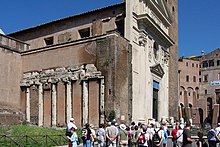Spes
Spes ( Latin ; ' hope ') is a spiritual virtue and in Roman mythology the personification of hope, especially for children and a good harvest. Its equivalent in Greek mythology was Elpis .
presentation
Spes was portrayed as a slender girl who easily floated on her toes. In her right hand she held a flower. In type it resembled the ancient images of the fully clothed Venus . At her side was a crow as a symbol of long duration.
Statues of the Spes are among others
- in the Villa Ludovisi in Rome ,
- as a figure by Bertel Thorvaldsen on a high column above the grave of the Humboldt family in Berlin-Tegel,
- as a support for Thorvaldsen in the 2nd aedicula of the Glyptothek east facade in Munich, based on Thorvaldsen's sketch in marble by Arnold H. Lossow .
Spes by Bertel Thorvaldsen , Humboldt-Grabstätte, Berlin-Tegel
Spes sculpture in the Thorvaldsen Museum , Copenhagen
Spes , wall painting in Saint Aloysius Church, Bowling Green, Ohio
cult
Since the 5th century BC Their cult was established in Rome . 477 BC After a victory over the Etruscans of Spes , the consul Gaius Horatius Pulvillus consecrated a temple on the Esquiline.
In the middle of the 3rd century BC A temple on the Forum Holitorium (the vegetable market) in Rome was consecrated to her by the consul Aulus Atilius Caiatinus. The temple was destroyed and rebuilt several times, last consecrated by Germanicus in the year 17. Remains of the temple are preserved as part of the Church of San Nicola in Carcere .
Outside of Rome is 110 BC. A temple of Spes, Fides and Fortuna in Capua is attested.
In the variant of the Spes Victrix, the hope of the emperor's victories over Rome's external enemies was venerated. Some cities in Asia Minor not only worshiped Spes Victrix, but also occasionally stamped the Spes Victrix as a personified hope on the reverse of their bronze coins. This documents how much the cities of Asia Minor had come closer to Rome and its emperors in their cults.
literature
- René Bloch: Spes. In: The New Pauly (DNP). Volume 11, Metzler, Stuttgart 2001, ISBN 3-476-01481-9 , column 811 f.
- Friedrich Wilhelm Hamdorf: Spes . In: Lexicon Iconographicum Mythologiae Classicae (LIMC). Volume VII, Zurich / Munich 1994, pp. 804-806.
- Georg Wissowa : Spes . In: Wilhelm Heinrich Roscher (Hrsg.): Detailed lexicon of Greek and Roman mythology . Volume 4, Leipzig 1915, Col. 1295-1297 ( digitized version ).
Web links
- Spes in: The large art dictionary by PW Hartmann , printed in 1996
Individual evidence
- ^ Titus Livius Ab urbe condita 2, 51, 2; Dionysius of Halicarnassus Roman Antiquities 9, 24, 4.
- ↑ Cicero De Legibus 2, 28; Tacitus Annals 2, 49.
- ↑ Titus Livius Ab urbe condita 25, 7, 6; Cassius Dio 50, 10, 3.
- ↑ CIL 10,3775 .
- ↑ Karola and Nollé, Götter Städtische Feste - Asia Minor Coins of the Roman Empire, p. 98





